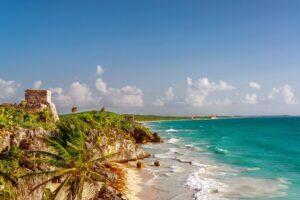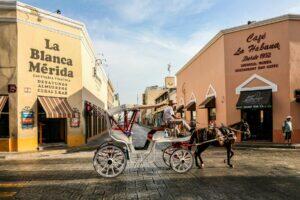Fodor's Expert Review Dzibilchaltún
More than 16 square km (6 square miles) of land here is cluttered with mounds, platforms, piles of rubble, plazas, and stelae. Although only a few buildings have been excavated, historians find Dzibilchaltún fascinating because of the sculpture and ceramics from all periods of Maya civilization that have been unearthed here. The area may have been settled as early as 500 BC and was inhabited until the time the Spanish arrived. At its height, there were around 40,000 people living here.
The most notable structure is the tiny Templo de las Siete Muñecas (Temple of the Seven Dolls). It's a long stroll down a flat dirt track lined with flowering bushes and trees to get to the low, trapezoidal temple that is an elegant example of the late Preclassic Period style. During the spring and fall equinoxes, sunbeams fall at the exact center of two windows opposite each other inside one of the temple rooms. A similar phenomenon happens during the full moon that occurs between March 20 and... READ MORE
More than 16 square km (6 square miles) of land here is cluttered with mounds, platforms, piles of rubble, plazas, and stelae. Although only a few buildings have been excavated, historians find Dzibilchaltún fascinating because of the sculpture and ceramics from all periods of Maya civilization that have been unearthed here. The area may have been settled as early as 500 BC and was inhabited until the time the Spanish arrived. At its height, there were around 40,000 people living here.
The most notable structure is the tiny Templo de las Siete Muñecas (Temple of the Seven Dolls). It's a long stroll down a flat dirt track lined with flowering bushes and trees to get to the low, trapezoidal temple that is an elegant example of the late Preclassic Period style. During the spring and fall equinoxes, sunbeams fall at the exact center of two windows opposite each other inside one of the temple rooms. A similar phenomenon happens during the full moon that occurs between March 20 and April 20.
Another attraction is the ruined open chapel built by the Spaniards for the indigenous people. Actually, to be accurate, the Spanish forced indigenous laborers to build it for themselves, in a sort of pre-Hispanic "separate but equal" scenario.
One of the best reasons to visit Dzibilchaltún, though, is Xlacah Cenote. The site's sinkhole, with crystalline water the color of smoked green glass, is ideal for a cooling swim after walking around the ruins. Before leaving, visit the small but impressive Museo Pueblo Maya, which contains the seven crude dolls that gave the Temple of the Seven Dolls its name. It also traces the area's Hispanic history, and highlights contemporary crafts from the region.
READ LESS





